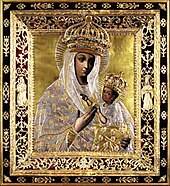Budslaw
| |
|---|---|
| Agrotown | |
 Church of the Assumption of the Blessed Virgin Mary Church of the Assumption of the Blessed Virgin Mary | |
 | |
| Coordinates: 54°47′0″N 27°27′0″E / 54.78333°N 27.45000°E / 54.78333; 27.45000 | |
| Country | Belarus |
| Region | Minsk Region |
| District | Myadzyel District |
| Elevation | 172 m (564 ft) |
| Time zone | UTC+3 (MSK) |
| Area code | +375 1797 |
Budslaw or Budslau (Belarusian: Будслаў, romanized: Budslaŭ; Russian: Будслав, romanized: Budslav; Polish: Budsław) is an agrotown in Myadzyel District, Minsk Region, Belarus. It is located 150 kilometres (93 mi) north of the capital Minsk.
The main landmark is the Catholic Minor Basilica of the Assumption of the Blessed Virgin Mary consecrated in 1643. The church is known for the icon of Our Lady of Budslau. The annual celebration in honor of the icon (Budslaw Fest [be]), which takes place on July 2, was added to the UNESCO Intangible Cultural Heritage List in 2018.
History

Budsław was founded in 1504 and granted to the Bernardines from Vilnius by King Alexander Jagiellon. The Bernardines first erected a chapel, then a wooden church in 1589, and then a brick church in 1643–1645. Town rights were confirmed by King Augustus II the Strong. It was administratively located in the Oszmiana County in the Vilnius Voivodeship of the Polish–Lithuanian Commonwealth.
Following the Second Partition of Poland (1793), it was annexed by the Russian Empire, within which it belonged to the Vilna Governorate. In the interbellum, it was part of reborn Poland, within which it was located in the Wilno Voivodeship. According to the 1921 Polish census, the population was 88.2% Polish, 7.2% Belarusian, and 4.6% Jewish.
| Year | Pop. | ±% |
|---|---|---|
| 1859 | 485 | — |
| 1921 | 626 | +29.1% |
| Source: | ||
Following the joint German-Soviet invasion of Poland, which started World War II in September 1939, the village was occupied by the Soviet Union until 1941, then by Germany until 1944. The Germans subjected all Jews over the age of 12 to forced labour, and carried out three massacres of Jews, and some Poles and Belarusians. In 1944 it was re-occupied by the Soviet Union, which annexed it from Poland in 1945.
Notable residents

- Vincent Žuk-Hryškievič (1903–1989), Belarusian emigre politician, President of the Rada of the Belarusian Democratic Republic (1970-1982)
Notes
References
- Celebration in honor of the Budslaŭ icon of Our Lady (Budslaŭ fest)
- ^ Słownik geograficzny Królestwa Polskiego i innych krajów słowiańskich, Tom XV. Część I (in Polish). Warszawa. 1900. p. 261.
{{cite book}}: CS1 maint: location missing publisher (link) - ^ Skorowidz miejscowości Rzeczypospolitej Polskiej. Tom VII. Część II (in Polish). Warszawa: Główny Urząd Statystyczny. 1923. p. 20.
- Megargee, Geoffrey P.; Dean, Martin (2012). The United States Holocaust Memorial Museum Encyclopedia of Camps and Ghettos 1933–1945. Volume II. Indiana University Press, United States Holocaust Memorial Museum. pp. 1171–1172. ISBN 978-0-253-35599-7.
- Dr. Vincent Žuk-Hryškievič, VIth President of the Rada of the Belarusian Democratic Republic (Доктар Вінцэнт Жук-Грышкевіч, VI Старшыня Рады БНР)(in Belarusian)